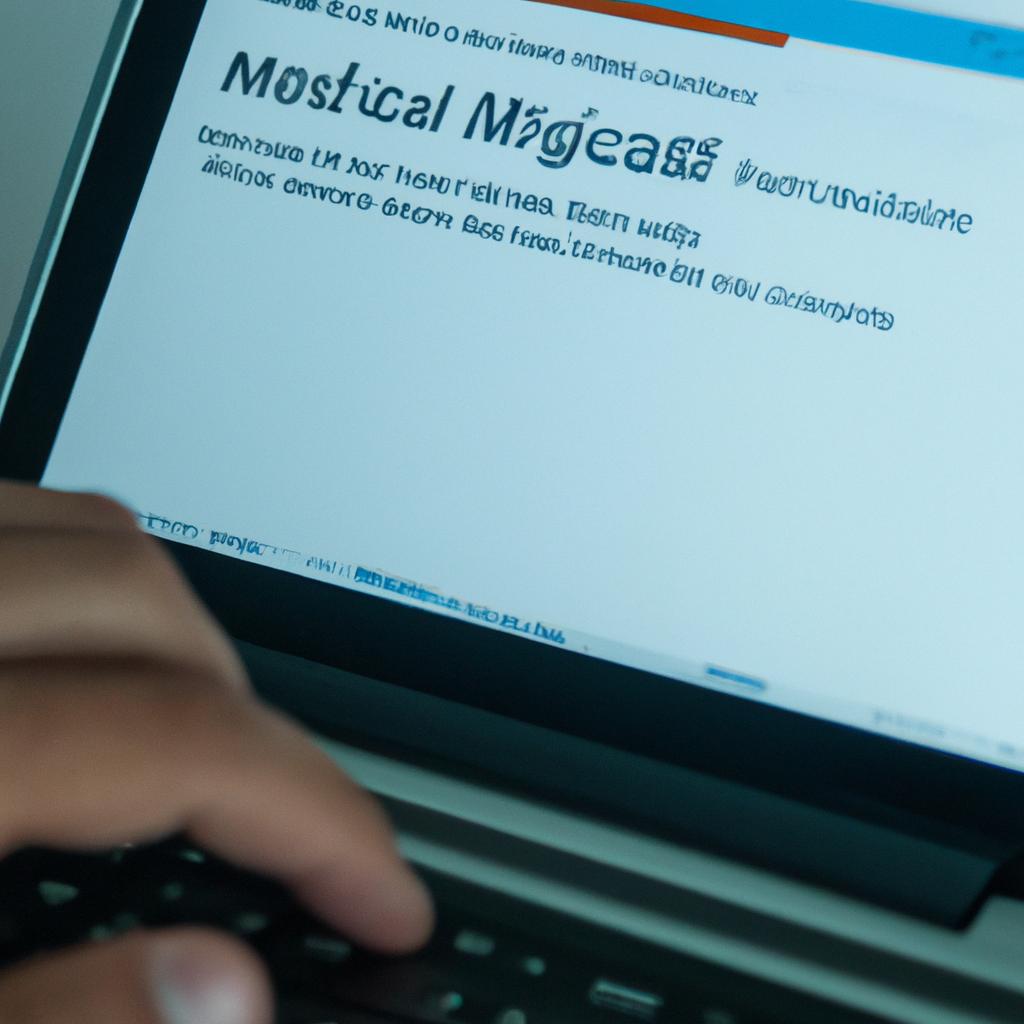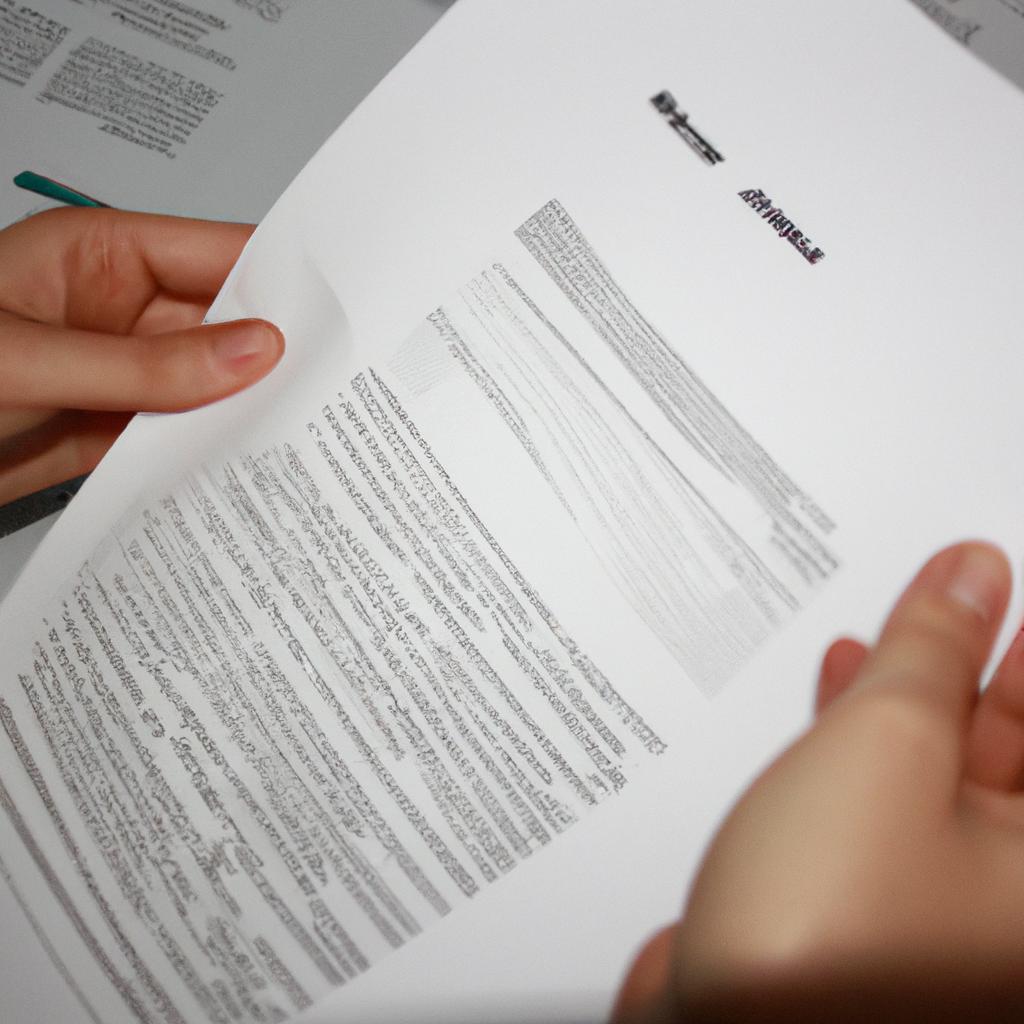Difficulty Swallowing in Body Myositis: Autoimmune Myositis

Difficulty swallowing, also known as dysphagia, can be a debilitating symptom in patients with body myositis. Body myositis is an autoimmune disease characterized by inflammation of the muscles, leading to muscle weakness and atrophy. This condition affects various muscle groups throughout the body, including those responsible for swallowing. For instance, let us consider the case of Sarah, a 45-year-old woman diagnosed with autoimmune myositis. She experiences great difficulty when attempting to swallow both solid foods and liquids, resulting in reduced food intake and weight loss.
The etiology behind difficulty swallowing in body myositis lies within the underlying immune-mediated inflammatory process that targets the muscles involved in swallowing. The exact mechanisms through which this occurs are still not fully understood; however, research suggests that it may involve infiltration of inflammatory cells into the affected muscles and subsequent damage to their structure and function. Consequently, weakened or damaged muscles fail to contract properly during swallowing movements, causing impaired transit of food from the mouth to the stomach.
Understanding the impact of difficulty swallowing in body myositis is crucial for healthcare professionals caring for these patients. Not only does this symptom significantly affect their quality of life due to challenges related to nutrition and hydration but it also poses potential risks such as mal nutrition, dehydration, and aspiration pneumonia. Malnutrition can occur as a result of reduced food intake due to difficulty swallowing, leading to deficiencies in essential nutrients and weight loss. Dehydration may also be a concern if patients are unable to drink enough fluids due to their swallowing difficulties. Additionally, the risk of aspiration pneumonia increases when food or liquids enter the airway instead of the esophagus during swallowing, potentially leading to lung infections.
Management of difficulty swallowing in body myositis involves a multidisciplinary approach that includes medical interventions and lifestyle modifications. Medications such as corticosteroids or immunosuppressive drugs may be prescribed to reduce inflammation and muscle damage. Physical therapy and speech therapy can help strengthen the muscles involved in swallowing and improve coordination. In some cases, dietary modifications like altering food textures or using thickening agents may be recommended to make swallowing easier and safer.
It is important for individuals with difficulty swallowing in body myositis to work closely with their healthcare team to develop an individualized management plan. Regular monitoring and follow-up appointments are necessary to assess progress and make any necessary adjustments to treatment strategies.
If you have specific questions or need further information regarding difficulty swallowing in body myositis or its management, I’m here to assist you!
Overview of Body Myositis
Imagine waking up one day and finding it difficult to swallow your breakfast. This seemingly simple task becomes a challenge, leading to frustration and discomfort. Such difficulties in swallowing, known as dysphagia, are often associated with body myositis, an autoimmune muscle disease. In this section, we will provide an objective overview of body myositis, its symptoms, and the impact it has on patients’ lives.
Body myositis is a rare inflammatory disorder that primarily affects skeletal muscles. It falls under the umbrella term “autoimmune myositis,” which encompasses various forms of muscle inflammation caused by the immune system mistakenly attacking healthy tissue. While body myositis can affect people of all ages, it typically manifests between the ages of 30 and 60.
Individuals diagnosed with body myositis experience progressive weakness in their skeletal muscles over time. As these muscles weaken, they may become unable to perform everyday tasks such as walking or lifting objects. Furthermore, dysphagia commonly accompanies body myositis due to weakened throat muscles responsible for swallowing food and liquids effectively.
To grasp the profound impact this condition has on individuals’ lives, consider the following emotional aspects:
- Frustration: The inability to eat normally can lead to immense frustration and feelings of helplessness.
- Isolation: Difficulties in eating can make social gatherings centered around meals challenging and isolating.
- Anxiety: Concerns about choking or not being able to consume enough nutrients can cause anxiety.
- Dependence: Severe cases may require assistance from caregivers or specialized feeding methods.
The table below summarizes key information related to body myositis:
| Key Information | |
|---|---|
| Prevalence | Rare |
| Age Range | Typically 30 – 60 |
| Symptom | Progressive weakness |
| Associated Complication | Dysphagia |
Understanding the impact of body myositis and its associated dysphagia is crucial for both healthcare professionals and affected individuals. In the following section, we will delve into the underlying causes of difficulty swallowing in body myositis patients, providing insights that can aid in diagnosis and treatment.
[Continue to Causes of Difficulty Swallowing]
With an understanding of body myositis as a progressive muscle disease leading to difficulties in swallowing, it becomes essential to explore the factors contributing to this symptom.
Causes of Difficulty Swallowing
Difficulty swallowing, or dysphagia, is a common symptom experienced by individuals with body myositis. This autoimmune muscle disease affects the muscles in various parts of the body, including those responsible for swallowing. In this section, we will explore the causes of difficulty swallowing in body myositis and how it impacts patients.
One real-life example that highlights the challenges faced by individuals with body myositis and difficulty swallowing is Sarah’s case. Sarah, a 42-year-old woman diagnosed with dermatomyositis, experiences significant difficulty when trying to eat solid foods due to weakened throat muscles. As a result, she has had to modify her diet to include only soft or pureed foods and liquids. This adjustment has affected not only her physical health but also her emotional well-being as she struggles with feelings of frustration and isolation.
The causes of difficulty swallowing in body myositis can be attributed to several factors:
-
Muscle weakness: The primary cause of dysphagia in body myositis is muscle weakness affecting the muscles involved in swallowing. Weakness in these muscles leads to impaired movement during the swallowing process.
-
Inflammation: Body myositis involves inflammation within the muscles themselves. Inflamed muscles can become stiff and less flexible, making it challenging for them to contract properly during swallowing.
-
Fibrosis: Prolonged inflammation may lead to fibrosis or scarring within the muscles involved in swallowing. This scarring further impairs their ability to function effectively.
-
Aspiration risk: Difficulty swallowing increases the risk of food or liquid entering the airway instead of going down into the stomach (aspiration). This can lead to complications such as pneumonia or choking.
To better understand how difficulty swallowing affects individuals with body myositis, consider the following table:
| Emotional Impact | Physical Impact | Social Impact |
|---|---|---|
| Frustration | Weight loss | Isolation |
| Anxiety | Malnutrition | Reduced appetite |
| Depression | Dehydration | Difficulty eating in public |
In conclusion, difficulty swallowing is a significant challenge faced by individuals with body myositis. Muscle weakness, inflammation, fibrosis, and the risk of aspiration contribute to this symptom. The emotional, physical, and social impacts can be profound for patients like Sarah as they navigate through altered diets and cope with limitations on their ability to enjoy meals or eat in public.
Moving forward into the next section about “Symptoms and Diagnosis,” we will delve deeper into other manifestations of body myositis and explore how healthcare professionals diagnose this condition.
Symptoms and Diagnosis
Difficulty Swallowing in Body Myositis: Autoimmune Myositis
Causes of Difficulty Swallowing
Difficulty swallowing, known as dysphagia, is a common symptom experienced by individuals with body myositis. This autoimmune disorder affects the muscles and can lead to weakness and inflammation, resulting in impaired function of the esophagus. One example that highlights this issue involves a 54-year-old male patient diagnosed with body myositis. He reported progressive difficulty in swallowing solid foods over several months, leading to weight loss and malnutrition.
The causes of dysphagia in body myositis can be attributed to various factors:
- Muscle Weakness: The weakened muscles involved in swallowing fail to propel food down the esophagus effectively.
- Inflammation: Inflammatory processes within the affected muscles result in scarring, fibrosis, and reduced muscle contractility.
- Esophageal Dysfunction: Abnormal muscular contractions or relaxation of the esophagus can impede proper movement of food.
- Connective Tissue Involvement: Autoimmune-mediated damage may extend beyond muscle fibers into connective tissues surrounding the esophagus, contributing to swallowing difficulties.
Patients experiencing difficulty swallowing due to body myositis often present with additional symptoms such as fatigue, muscle pain, and joint stiffness. Diagnosis typically involves an assessment of clinical features supported by specific laboratory tests (e.g., creatine kinase levels) and imaging studies (e.g., magnetic resonance imaging). It is crucial for healthcare providers to recognize these signs early on to initiate appropriate management strategies promptly.
Table: Impact of Difficulty Swallowing on Individuals with Body Myositis
| Consequences | Emotional Response |
|---|---|
| Limited dietary choices | Frustration |
| Social isolation | Loneliness |
| Fear of choking | Anxiety |
| Malnutrition | Concern |
Note: The emotional responses mentioned above are not exhaustive and can vary from individual to individual.
Despite the challenges posed by dysphagia in body myositis, there is hope for managing this symptom effectively. In the subsequent section on “Treatment Options for Difficulty Swallowing,” we will explore various strategies aimed at improving swallowing function and enhancing the quality of life for individuals with autoimmune myositis.
[Transition sentence] Moving forward, let us delve into the available treatment options that address difficulty swallowing associated with body myositis.
Treatment Options for Difficulty Swallowing
Difficulty swallowing, also known as dysphagia, is a common symptom in body myositis: autoimmune myositis. This debilitating condition affects the muscles of the body, including those responsible for swallowing. In this section, we will explore various treatment options available to manage difficulty swallowing in individuals with body myositis.
One case study that exemplifies the challenges faced by patients with difficulty swallowing involves a 45-year-old woman diagnosed with body myositis. She experienced progressive muscle weakness throughout her body, including her throat muscles, which made it increasingly difficult for her to swallow both solid and liquid foods. Her quality of life was significantly impacted as she struggled to eat without choking or developing aspiration pneumonia.
To address difficulty swallowing in body myositis, several treatment options can be considered:
- Medications: Some medications such as corticosteroids may help reduce inflammation in the muscles involved in swallowing. This can alleviate symptoms and improve overall swallowing function.
- Speech therapy: Working with a speech therapist who specializes in dysphagia can be beneficial for individuals with difficulty swallowing. They can provide exercises and techniques that strengthen the throat muscles and enhance coordination during the swallowing process.
- Dietary modifications: Adjusting the consistency of food and beverages can make them easier to swallow. Thickening liquids or pureeing foods may be necessary to prevent choking or aspiration.
- Feeding tube placement: In severe cases where oral intake becomes too challenging or unsafe, a feeding tube may be recommended. This enables adequate nutrition while bypassing the need for oral ingestion.
- Frustration caused by an inability to enjoy meals
- Fear of choking or aspirating on food or beverages
- Isolation due to dietary restrictions impacting social interactions
- Concerns about long-term consequences on overall health
Table (markdown format):
| Treatment Options | Pros | Cons |
|---|---|---|
| Medications | Reduce inflammation | Potential side effects |
| Speech therapy | Strengthen throat muscles | Requires ongoing sessions |
| Dietary modifications | Easier swallowing | Impact on food enjoyment |
| Feeding tube placement | Ensures adequate nutrition | Loss of oral intake experience |
In managing difficulty swallowing in daily life, individuals with body myositis may need to adopt certain strategies and make lifestyle adjustments. This will be further explored in the subsequent section about “Managing Difficulty Swallowing in Daily Life.” By implementing these treatment options and seeking appropriate support, patients can improve their ability to swallow and enhance their overall quality of life. Transitioning into the next section, we will now delve into practical ways to manage this condition on a day-to-day basis.
Managing Difficulty Swallowing in Daily Life
Individuals diagnosed with Body Myositis often experience difficulty swallowing, a symptom that can significantly impact their daily lives. In this section, we will explore various strategies and techniques to manage difficulty swallowing effectively.
For instance, let’s consider the case of Lisa, a 42-year-old woman diagnosed with autoimmune myositis who struggles with dysphagia. To cope with her condition, Lisa has implemented several measures into her daily routine:
-
Diet Modifications: Lisa follows a modified diet consisting of softer foods and liquids that are easier to swallow. She avoids dry or hard-to-chew items such as tough meats or crusty bread. By adapting her food choices, Lisa reduces the risk of choking incidents and ensures proper nutrition.
-
Positioning Techniques: Lisa finds it helpful to sit upright while eating and drinking. This position facilitates better control over her swallowing reflexes and minimizes discomfort during meals.
-
Swallowing Exercises: As part of her treatment plan, Lisa regularly performs prescribed swallowing exercises recommended by her healthcare provider. These exercises target strengthening the muscles involved in swallowing, promoting improved coordination and efficiency.
-
Assistive Devices: Lisa utilizes assistive devices like special utensils designed for individuals with swallowing difficulties. These tools provide added support while eating and enable more secure handling of food.
To illustrate the potential challenges faced by those managing difficulty swallowing due to body myositis further, consider the following emotional responses from affected individuals:
- Frustration: “It feels disheartening when I struggle to eat even simple meals.”
- Isolation: “I find it difficult to dine out or enjoy social gatherings because I worry about choking episodes.”
- Anxiety: “Each mealtime brings anxiety as I fear not being able to swallow properly.”
- Determination: “Despite these challenges, I am determined to persevere and find ways to make eating and drinking more manageable.”
To better understand the impact of difficulty swallowing, refer to the following table showcasing some common emotions experienced by individuals with body myositis:
| Emotions | Impact on Daily Life |
|---|---|
| Frustration | Difficulties in enjoying meals and maintaining nutrition |
| Isolation | Limited participation in social activities |
| Anxiety | Increased stress during meal times |
| Determination | Willingness to adapt and find effective coping strategies |
By implementing these management techniques and acknowledging the emotional challenges associated with difficulty swallowing, individuals like Lisa can enhance their quality of life despite the limitations imposed by body myositis.
Transitioning into the subsequent section about “Preventing Complications of Body Myositis,” it is essential to recognize that managing difficulty swallowing effectively not only enhances daily functioning but also contributes to preventing potential complications.
Preventing Complications of Body Myositis
Managing Difficulty Swallowing in Daily Life can be challenging for individuals with Body Myositis. To prevent complications and ensure a better quality of life, it is important to implement certain strategies and modifications. For instance, let’s consider the case of Sarah, a 45-year-old woman diagnosed with autoimmune myositis. Due to muscle weakness in her throat muscles, she experiences difficulty swallowing, which has significantly impacted her daily routine.
To address this issue effectively, there are several approaches that can be taken:
- Dietary adjustments: It is crucial for individuals like Sarah to modify their diet to make swallowing easier. This may involve altering the consistency of food by pureeing or blending it into a smoother texture. Additionally, avoiding dry or hard-to-chew foods and opting for softer alternatives can alleviate discomfort while eating.
- Speech therapy: Engaging in regular speech therapy sessions can help strengthen the muscles involved in swallowing and improve coordination between them. Techniques such as postural adjustments and specific exercises tailored to each individual’s needs can contribute to enhancing swallowing function.
- Assistive devices: The use of specialized assistive devices can aid individuals experiencing difficulty swallowing. These devices range from adaptive utensils designed for easier handling during meals to oral suction tools that help clear any excess saliva or phlegm present in the mouth.
Markdown bullet point list:
To manage difficulty swallowing effectively, here are some key considerations:
- Ensuring proper hydration through increased water intake
- Eating smaller, more frequent meals throughout the day rather than large portions at once
- Chewing food thoroughly before swallowing
- Taking adequate time during meals, allowing for breaks if needed
Table (3 columns x 4 rows):
| Strategies | Benefits | Challenges |
|---|---|---|
| Dietary adjustments | Easier ingestion | Limited food choices due to modification |
| Speech therapy | Improved muscle strength | Time commitment |
| Assistive devices | Enhanced eating experience | Initial cost and learning curve |
By implementing these strategies, individuals like Sarah can effectively manage the difficulty swallowing associated with Body Myositis. However, it is important to consult healthcare professionals for personalized recommendations based on individual needs and conditions. With the right management techniques in place, individuals can maintain a more comfortable and fulfilling daily life despite the challenges posed by this condition.





